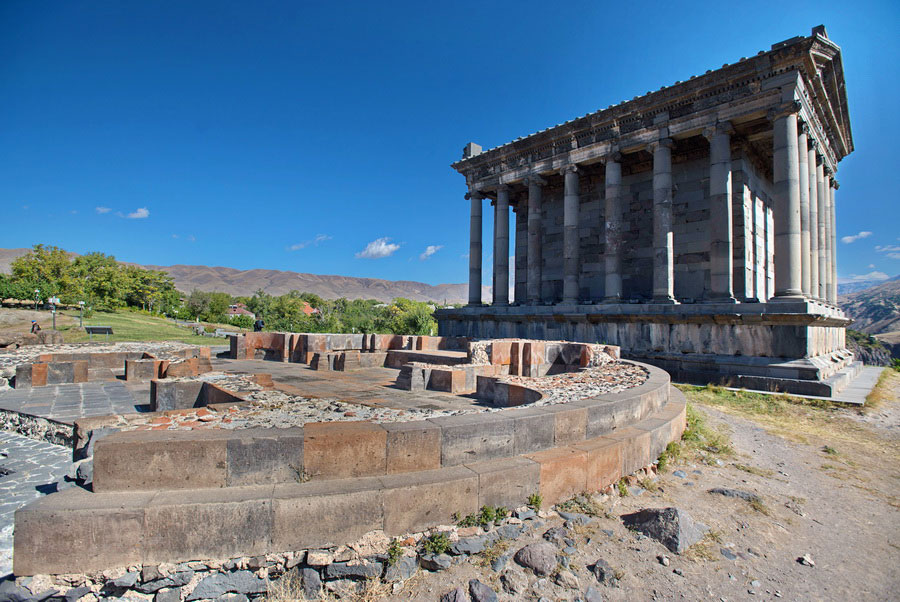
The history of Armenia is a unique world treasury full of great civilizations' chronicles, biographies of legendary people, dramatic moments connected with formation of Christianity. Armenia repeatedly suffered from conquerors; time and again it seemed that the name of Armenia was erased from the map forever. But Armenian people have survived and defended their existence in fierce battles.
Thirty thousand square kilometers which are occupied today by Republic of Armenia make up only a tiny part, less than one tenth of that huge historical Armenia, whose chronicles are a separate chapter in the world's history and culture.
Armenian uplands were on the way of major trading and military routes of the Ancient world connecting the East and the West. Such a beneficial position of Armenia was always envied by numerous conquerors. Therefore, the borders of Ancient Armenia were exposed to frequent changes, and Armenians had to move to new lands. That is why the history of Armenia is rich and infinite. But the most important events are as follows…
Ancient Tribes on the territory of Armenia
Ignoring the fact that the first people appeared in Armenia during the epoch of early Paleolith, the first pre-Armenian tribes (Urartians, Hourrites, Luvians etc.) which inhabited Armenian uplands, were mentioned in the 4th – 3rd millennia BC. According to one hypothesis they were Thracian-Phrygian tribes; the other one states that those were ancient Indo-European tribes which came from Asia Minor. The country's name, Armina, and Arminians were first mentioned in the cuneiform writings of the Persian tsar Darius I (522-486 BC)
Urartu
In the beginning of the 1 st millennium BC class distinctions appeared. The tribes of Armenian uplands united to form tribal unions (Uruatri, Nairi, Daiani etc.) on the basis of which in the 11 th century BC the powerful ancient slaveholding state Urartu with the capital in Tushpa (Van) was formed. During the period the intense ethnic unification of tribes of Armenian uplands and Armenian nationality took place.
In the 9th – 6th centuries BC the people of Urartu kingdom created the ancient civilization which defined the cultural future of ancient Armenia. The high level of this civilization was proved by the existence of writing, development of agriculture, cattle breeding and metallurgy as well as the highly developed ways of construction of such fortified cities as Erebuni, Teishebaini, Argishtikhinili etc.).
However, the internal contradictions, the absence of unity, the invasion intrusion of Assyrians caused the collapse of Urartu in the early 4th century BC.
Ervanduni
Urartu was replaced by Ervanduni, another ancient Armenian kingdom. The governors and the population of Ervanduni were already the representatives of Armenian-speaking ethnic group - the ancestors of modern Armenians.
Akhmenids
In 520 BC Armenian kingdom was conquered by Persians and remained as a part of Akhmenid Empire as a vassal state until Alexander the Great campaigns (330 BC).
Great Armenia
After the fall Persian power and with the beginning of Hellenistic epoch which arrived thanks to aggressive campaigns of Alexander the Great, Armenia entered the new era of its development. Read more...
Division of Armenia between Rome and Persia and Adoption of Christianity
During the first four centuries AD Armenia gradually lost its independence. Armenian kingdom was divided between two powerful empires – Roman Empire and Persian Sasanid state. Read more...
Splitting in Principialities. Fall of Sasanids
In the 5 th – 6 th centuries Armenia was still divided between East-Roman empire (Byzantium) and Persian Sasanid power. Read more...
Arabic Caliphate. Unification of Armenia by Bagratids
The devastating raids of Arabs forced the former Persian Armenia to accept the power of Arabic Caliphate. In 652 Armenia became a province of the caliphate. Read more...
Decline of Armenia. Invasion of Byzantium and Seljuk Turks
From the mid -11 th century Bagratid kingdom and its princedoms declined due to the impact of Byzantium which was free to act the weakening of the caliphate and pressure of the new enemies – Seljuk Turks. Read more...
Cilician Armenia
The beginning of Cilician kingdom is dated 1080. It was founded by Rubenian dynasty (Rubenids) which started from prince Ruben... Read more...
Armenian Zakarid Principality as a Part of Georgian Kingdom
As Armenian kingdom moved closer in Europe Armenian statehood began its revival on its historical territory (the Caucasian part of Armenia). Read more...
Armenia under Oppression of Ottoman Empire and Persia.
In the end of the 13th century Osman-bei founded his state in the outlying districts of Asia Minor. It was the birth of new great Ottoman Empire. Read more...
Russian Assistance in Struggle for Freedom
In the end of the 17th century Armenian princes asked Russian tsar Peter the Great for help. Read more...
Soviet Armenia
On May 28th , 1918 Russian Armenia was proclaimed independent republic. In September 1920 Turkey started the war against Armenia and occupied two thirds of its territory. Read more...
Independent Armenia
On August 23rd , 1990 during the 1st session of the Supreme Council of Armenia the declaration on “Independence of Armenia” was adopted. The Armenian Soviet Socialist Republic was abolished and independent Republic of Armenia was proclaimed. Read more...

